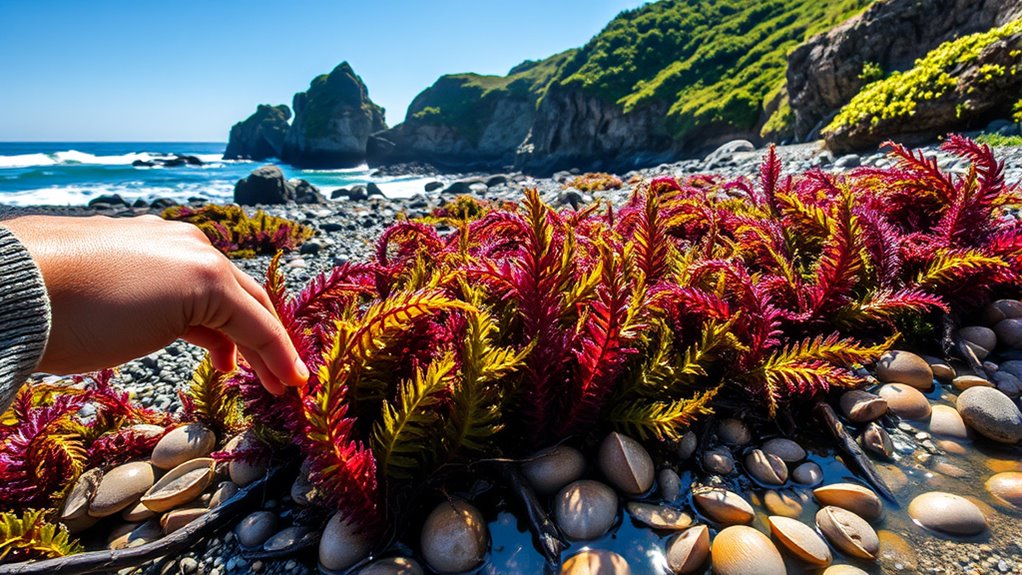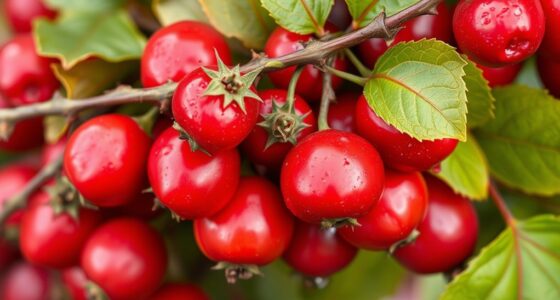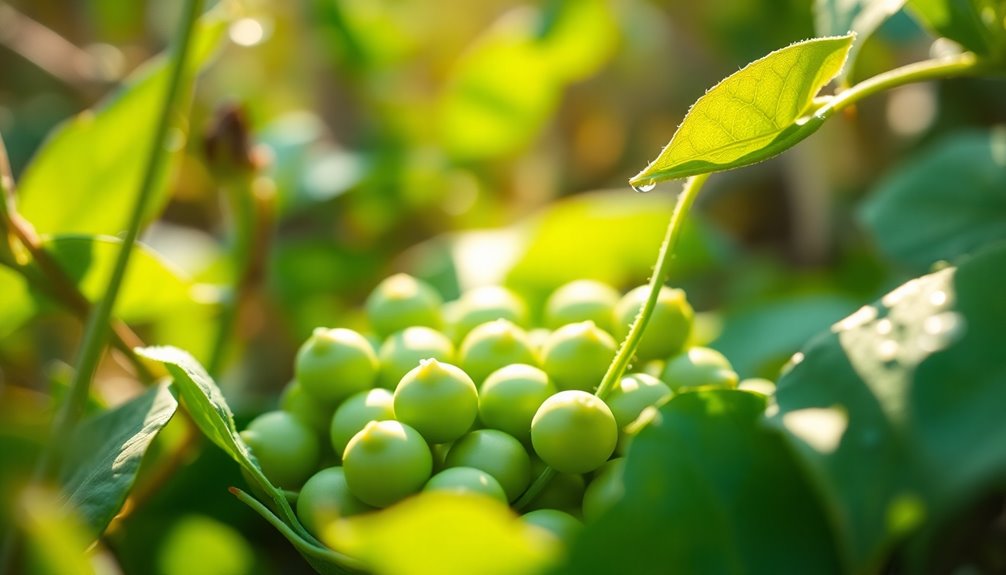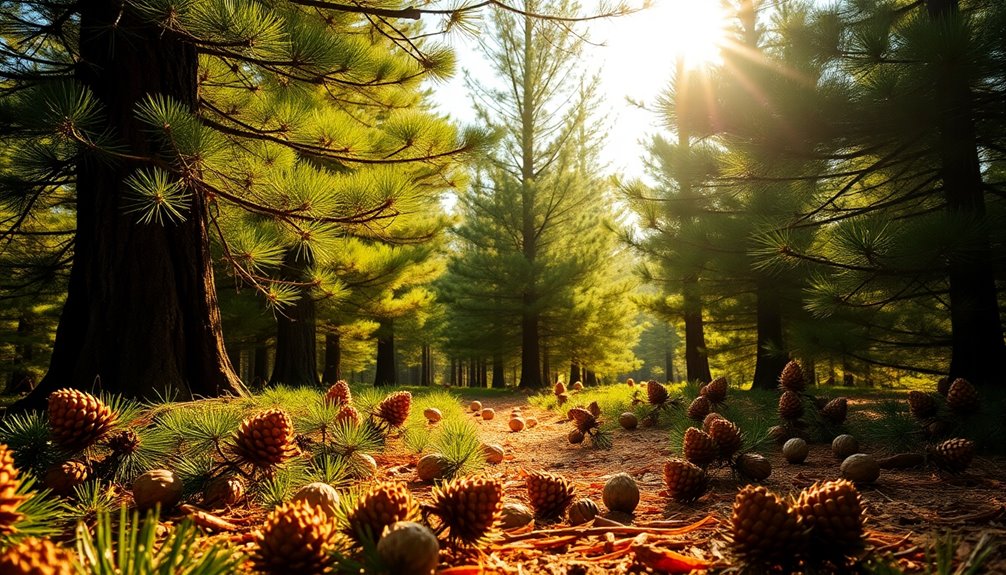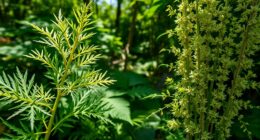To forage for seaweed safely, learn to identify edible regional varieties like kelp, bladderwrack, or green seaweeds, and follow sustainable harvesting methods that protect marine ecosystems. Check tide conditions, use proper tools, and wear safety gear to guarantee a safe outing. The best seasons are from January to May, in rocky, shallow coastal areas. For expert tips on harvesting, handling, and cooking, explore more details ahead.
Key Takeaways
- Identify regional edible seaweeds like kelp, bladderwrack, and red varieties, ensuring proper identification before harvesting.
- Follow safety precautions: check tides, weather, wear protective gear, and avoid hazards like rocks, wildlife, and strong currents.
- Harvest sustainably by pruning carefully, limiting to 25% biomass, and avoiding damage to the ecosystem during peak seasons.
- Use appropriate tools such as shears, knives, and waders, and target rocky shorelines during low spring tides for optimal foraging.
- Properly clean, cook, and store seaweed through drying, freezing, or pickling to maximize flavor, nutrients, and shelf life.
Identifying Edible Seaweeds and Their Regional Varieties

To identify edible seaweeds and understand their regional varieties, start by recognizing the main types: brown, red, and green seaweeds. Brown seaweeds include species like kelp (*Laminaria digitata*) and bladderwrack (*Fucus vesiculosus*), which often have a tough texture. Red seaweeds may appear brown but are typically vibrant red or purple, such as *Padina pavonia* (Peacock’s Tail). Green seaweeds are usually bright green and thrive in shallow waters. Your region influences which species you encounter; for example, the Pacific Northwest has bull kelp and giant kelp, while Maine features sugar kelp. Irish and Welsh coasts host species like *Laminaria hyperborea*. Recognizing these types helps you identify safe, edible seaweeds in various coastal environments. Proper identification also involves understanding the regional varieties and their distinctive features to avoid confusion with non-edible species. Being aware of regional species diversity can help prevent misidentification and ensure safe foraging. Additionally, familiarizing yourself with common goal tracking pitfalls can enhance your overall foraging practices by keeping your objectives clear and achievable.
Essential Safety Precautions for Coastal Foraging
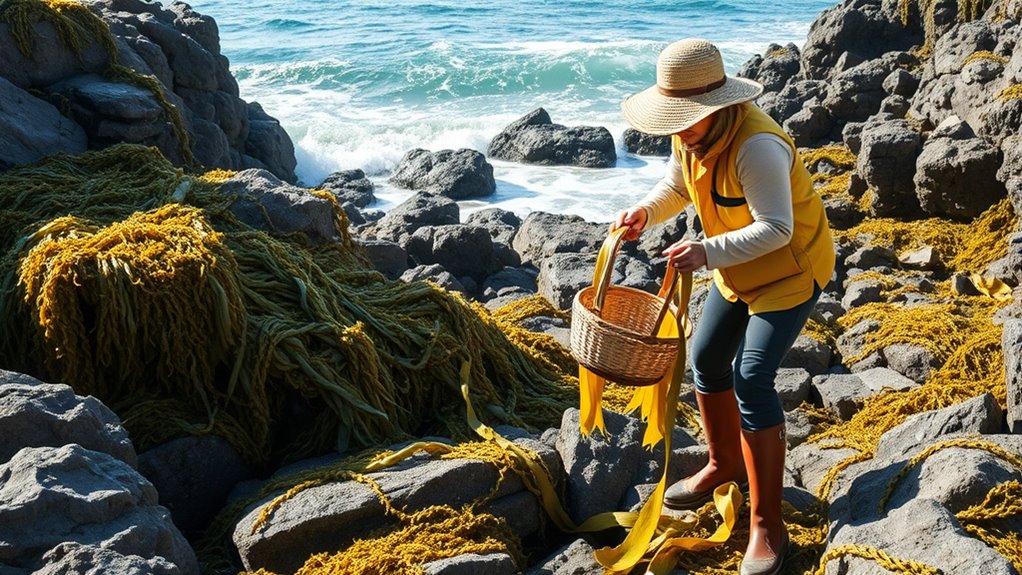
When foraging along the coast, paying attention to safety precautions helps prevent accidents and guarantees a positive experience. Always check weather and tidal conditions before heading out to avoid being caught in rising tides or rough surf.
Always check weather and tides before coastal foraging to stay safe and enjoy your adventure.
Wear suitable clothing and sturdy footwear to navigate rocky or slippery terrain safely. Protect yourself from sun exposure with sunscreen, hats, and sunglasses, and bring enough water and snacks to stay energized. Being aware of recommended equipment for coastal foraging can help you gather seaweed more efficiently and safely.
Share your plans and location with someone else, and consider carrying a communication device for emergencies. It is also helpful to familiarize yourself with coastal safety guidelines to better understand how to handle potential hazards in the environment. Staying informed about ceiling fan safety features can also help prevent accidents during your outdoor activities. Be cautious around wildlife, rocky surfaces, and waves, never turning your back on the sea.
Handle seaweed carefully, wash it thoroughly, and cook it properly to ensure safety. Additionally, understanding the best equipment for coastal foraging can enhance your safety and efficiency during your adventure. These precautions keep you safe while enjoying your coastal foraging adventure.
Practicing Sustainable Harvesting Techniques

Practicing sustainable harvesting techniques is essential to protect seaweed populations and maintain healthy marine ecosystems. Instead of ripping seaweed from rocks, you should prune it carefully to allow for regrowth. Never harvest more than 25% of the biomass in an area, and always leave the root system or holdfast intact. This ensures the seaweed can recover quickly. Incorporate trend research to stay informed about the most effective and eco-friendly harvesting methods. Harvest during peak growing seasons after reproduction, using hand tools to minimize environmental disturbance. Focus on selectively cutting mature seaweed, avoiding younger plants and avoiding damage to surrounding organisms. Regularly monitor regrowth and adjust your practices accordingly. Avoid destructive methods like trawling, and consider salvaging naturally cast seaweed on beaches. Implement rotational harvesting to give different areas time to recover, supporting a healthy marine environment. Additionally, understanding the importance of marine biodiversity can guide responsible harvesting practices that benefit entire ecosystems. Incorporating scientific studies can further enhance sustainable techniques and promote the resilience of marine habitats. Staying informed about environmental indicators and ecosystem health helps ensure that harvesting remains sustainable and ecologically beneficial. Maintaining awareness of climate change impacts can also help adapt harvesting practices to changing ocean conditions, ensuring long-term sustainability.
Optimal Seasons and Ideal Locations for Seaweed Gathering
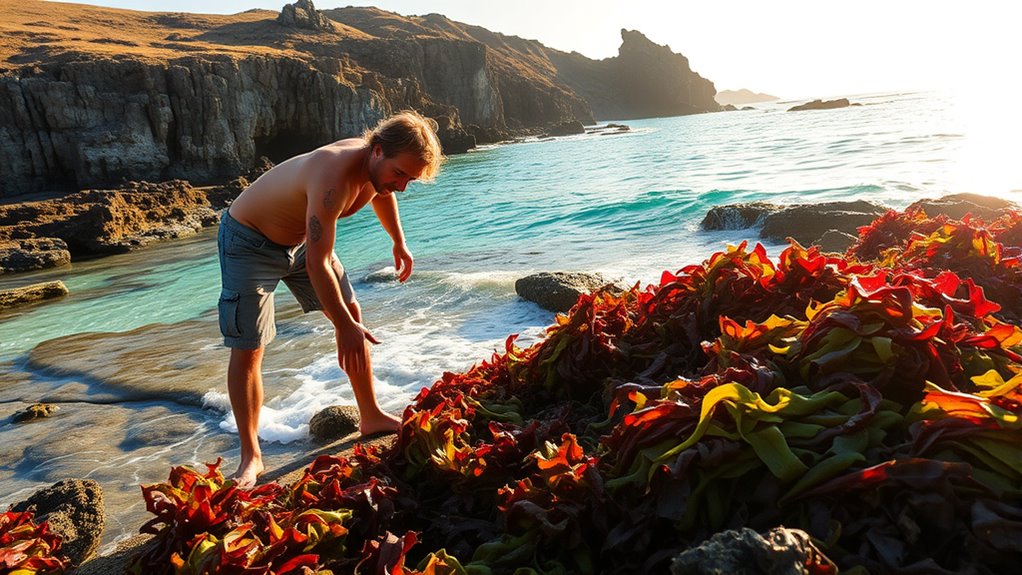
Understanding the best times and places to gather seaweed can considerably enhance your harvest quality and sustainability. The prime season runs from January to May, when growth is rapid and the seaweed is at its tastiest. During this period, seaweeds are actively growing, especially after autumn when cooler waters promote lush development.
Avoid harvesting during spawning months from May to September, as quality diminishes. For ideal locations, focus on rocky shores and shallow waters exposed at low tide, especially in areas with strong currents that supply nutrients. Exposed coasts and tidal zones are perfect, as they support larger, healthier seaweeds.
Always check local regulations and tide schedules to ensure safe and sustainable foraging, targeting spring tides for easier access and better yields.
Must-Have Equipment and Tools for Successful Foraging

Equipping yourself with the right tools is vital for a successful seaweed foraging trip. Grape shears are perfect for safely harvesting seaweed, especially around rocks. Small knives or scissors help cut seaweed and other edibles without damaging them. A Hori-Hori knife offers versatility for digging and cutting various coastal materials. Proper tool maintenance can extend the lifespan of your gear and ensure safety during foraging.
A sturdy foraging basket makes collecting and carrying your harvest easy. Protect your hands with gloves, especially when handling sharp or slippery seaweed. Waterproof boots or waders are essential for wading into water, while goggles or masks improve underwater visibility. A snorkel enables surface exploration, and a life jacket adds safety in deeper waters.
Always carry a waterproof bag for tools and seaweed, ensuring your gear stays dry and organized. Additionally, understanding regulatory compliance and best practices can help you forage responsibly and avoid legal issues. Being aware of local regulations is crucial to ensure sustainable harvesting and protect marine ecosystems. Furthermore, knowledge of marine conservation can enhance responsible foraging and promote ecosystem preservation.
Preparing and Cooking Your Seaweed Harvest

Once you’ve harvested your seaweed, proper preparation is essential to reveal its full culinary potential. First, thoroughly wash your seaweed to remove sand, salt, and contaminants. Depending on the type, you can soak it to make it ready for raw dishes like salads or pasta. Drying seaweed enhances its texture and preserves it for later use; you can sun-dry or use hot air dryers. When cooking, steaming gently preserves its delicate flavors, while boiling suits tougher varieties. Roasting adds a crispy texture, and stir-frying offers a quick, flavorful option. Store your prepared seaweed properly—either by drying, freezing, or pickling—to maintain freshness and nutrients. Incorporating seaweed into soups, salads, or pasta adds flavor, nutrition, and versatility to your meals. Understanding the different types of seaweed can help you choose the best varieties for your culinary needs. Recognizing survivalism principles such as proper food preservation methods can ensure your harvest lasts longer and remains safe to eat. Additionally, being aware of AI-powered processing in food technology is increasingly influencing how seaweed and other ingredients are prepared and preserved. Proper handling techniques are essential to maximize shelf life and nutrient retention, especially considering the high nutrient content that seaweed offers.
Frequently Asked Questions
How Can I Distinguish Edible Seaweed From Toxic Varieties?
To differentiate edible seaweed from toxic varieties, start by observing color, shape, and habitat. Brown seaweeds like kelp and wakame are safe, while some red seaweeds need proper preparation.
Avoid blue-green algae in freshwater—they’re poisonous. Always identify species carefully, look for vibrant, healthy-looking plants, and forage away from industrial areas.
When in doubt, consult reliable guides or experts to guarantee you’re harvesting safe, edible varieties.
Are There Specific Permits or Regulations for Seaweed Foraging?
You need to tread carefully when it comes to permits for seaweed foraging, as regulations vary widely. Local rules may restrict where you can harvest, and some areas require permits, especially for commercial purposes.
State and federal agencies have established permits and guidelines to protect ecosystems. Don’t bite off more than you can chew—check the specific permits required in your area and follow regulations to stay on the right side of the law.
What Are Common Mistakes to Avoid During Harvesting?
When harvesting seaweed, you should avoid common mistakes like harvesting in poor weather, which can be dangerous and reduce quality.
Don’t cut too deeply or damage the plant, as it hampers regrowth.
Be mindful of tidal schedules and water quality to ensure safety and legality.
Handle the seaweed gently to prevent damage, and avoid overharvesting or disrupting ecosystems.
Respect seasonal closures and local regulations.
How Long Does It Take for Seaweed to Regrow After Cutting?
Ever wondered how long it takes for seaweed to bounce back after cutting? It varies based on species, environmental conditions, and harvesting methods.
Fast-growing species like Gracilaria can resprout in 25-30 days, while temperate types may take several months. Warmer waters and seasonal factors also influence regrowth speed.
Can I Forage for Seaweed During High Tide Safely?
You can forage for seaweed during high tide, but it’s riskier. The water covers many accessible areas, making it harder to reach seaweed without slipping. Strong currents and slippery rocks increase danger, so wear waterproof footwear with good grip.
It’s best to wait for low tide, especially during spring tides, to access more seaweed safely. Always check tide tables and be cautious of your surroundings to avoid accidents.
Conclusion
Now that you know how to identify, harvest, and prepare seaweed, you’re ready to explore the coast confidently. Did you know global seaweed production has doubled in the past decade, contributing considerably to sustainable food sources? By foraging responsibly, you not only enjoy fresh, nutritious seaweed but also support marine ecosystems. So, go ahead—embrace this rewarding activity and help preserve our precious coastal environments for generations to come.

